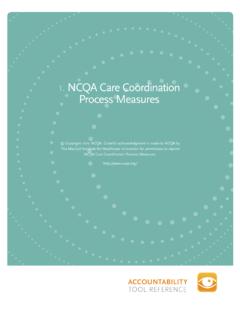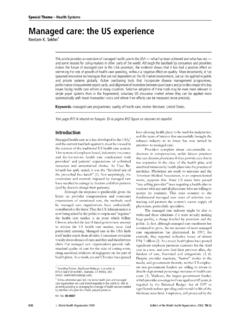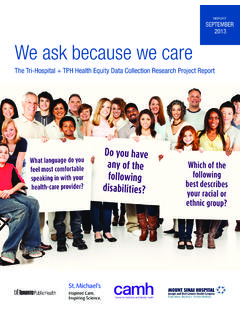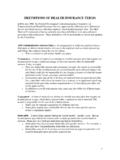Transcription of THE TRAINING CONNECTION S MPLOYMENT SPECIALISTS
1 THE TRAINING . CONNECTION SERIES FOR. EMPLOYMENT. SPECIALISTS . A Collection of Articles on Supported Employment and self Employment from The Job TRAINING & Placement Report Written by Cary Griffin and Dave Hammis Griffin-Hammis Associates, LLC. and The University of Montana Rural Institute Originally Published by The Job TRAINING & Placement Report To Subscribe, please contact Impact Publications GRIFFIN - HAMMIS. ASSOCIATES, LLC. CAREER PLANNING - BUILDING SOLID EMPLOYMENT. BY CARY GRIFFIN AND DAVE HAMMIS. When you decided on a college major, did you check the latest market surveys for the top jobs? Probably not. Most Americans, not all but most, chose majors that fit their personalities, their dreams, and the subjects they got the best grades in in high school. However, traditional job development for people with disabilities has been based on the market demand principle.
2 That approach is fading because, after over 50 years of trying to fit people with disabilities into jobs that an interest inventory or vocational assessment pinpointed, or that a labor demand survey emphasized, job retention remains extremely low. People have dreams, talents, and personal interests that are revealed daily if job developers and employment SPECIALISTS care to observe. These bits of personal genius are what drive us to success in our chosen careers. It may seem presumptuous to speak of careers for many individuals without a work history, but by prospecting to reveal a life-work theme, the opportunity for job retention and satisfaction increases. In the long run, this means satisfying the customers (the job seeker, funders, and the employer) and reducing costs by doing things right the first time and by garnering a reputation for quality employment services.
3 Now certainly career planning is not indicated for the individual walking into the office who needs a paycheck tomorrow and does not really care about where they work due to more pressing matters like making a rent payment or feeding their children. But for many people with significant disabilities who will get only one or two chances to retain employment before the system suggests they are unemployable, career planning can mean the difference between freedom and life-long clienthood. Studies indicate that the average person served in a Community Rehabilitation Program (CRP) receives less than two hours of career planning annually. Career planning is a loosely defined approach to job acquisition and growth that is highly interactive, self -determined, person-centered, community-referenced, outcome-focused, and unique for each job seeker. Career planning is a flexible and action-oriented process that leads to multiple jobs across a lifetime for individuals with significant disabilities.
4 The disability is unimportant in that it is the series of employment contacts, supports, and actions taken that determine the ultimate success of the individual. Disability is too often used as an excuse for why a person cannot work. All people can work to some degree when provided the necessary supports. People are not unemployed because they have disabilities; people are unemployed because they do not have jobs. The career planning process is based upon various components of Person-Centered Planning. The individual job seeker is the center of attention and direction. This job seeker requests the presence of those close to him or her in an initial meeting to review past accomplishments and future aspirations. Having a facilitator who understands best employment practice also serves to move the team forward in its work. The next step involves developing a plan of action for starting or re-directing travels down the career path.
5 The job seeker may take the role of team leader to better self -direct and guide the process. Many individuals have been excluded from society and may need assistance in getting connected to the job market. A rehabilitation professional such as a job developer, Vocational Rehabilitation Counselor or case manager may be engaged as co-team leader. Family members also often serve effectively in this role and offer typical supports that most of us utilized in creating our careers and a vision for the future. An employer member (or brief consultant ) who knows the individual or family, and who can utilize their peer network and business influence, may be recruited to connect the job seeker with other employers. Whoever takes on the leadership role is responsible for pulling together a preliminary career support team to help devise career opportunities. The planning team meets initially to review employment history to date, discover the vocational preferences of the individual, and to offer personal and professional relationships to enhance job search or advancement.
6 An analysis of each members' community connections and employment history creates potential contacts and insights that will help clarify the employment action steps. Too often, traditional rehabilitation processes create barriers to career development by relegating people to menial jobs or ineffective TRAINING and evaluation. The career planning approach views jobs as stepping stones to a career that, like most workers, is created through experiential refinement of what we enjoy vocationally. Remembering that all of us have great latitude in how we select and/or change our careers is important when supporting someone else. In career planning we look beyond typical modes of support because these have proven largely unsuccessful or unsatisfactory to people with disabilities. We facilitate community and job site relationships that advance careers, utilize technology that increases competence, and access resources such as Plans for Achieving self Support (PASS) that can be directed by the consumer.
7 Various person-centered planning tactics are merged to create a process that exhibits and utilizes the talents of the job seeker and the planning team. Typically, a Background Map helps discover the family, life, and work history used by the team to build a resume and to reveal connections to employers ( , the job seeker's brother works for Intel and can advocate internally). A. Relationships Map allows us to identify key connections to the job market, references for the Resume or Portfolio, and possible employers (family friends who run businesses, for example). A Preferences Map is also completed that narrows the type of work desired. A Dreams Map is also initiated to set the desired direction. Throughout the process the individual's needs and desires are given center-stage. Job creation or carving are often the methods required to address the specific support needs and aspirations of the individual.
8 One mantra to remember as life patterns and career dreams reveal themselves in the process is to keep asking: Where does the dream make sense? Asking this question leads the job seeker and the job developer (or family member, employment specialist, or friend who is helping with the job search) to identify environments where others do work similar to the dream. For instance, ace behaviorist for the State of Colorado, and Community Circle, Joe Schiappacasse, recalls an individual with the career dream of becoming a NASCAR driver. The problem was that Mike . lived in rural area with no race track where he might start his career. And, oh yes, Mike was legally blind. Joe arranged a meeting for Mike with some folks who worked where the dream made sense.. The guys at the local Auto Parts store were taken by surprise when they saw Mike was blind, but they all, to some degree, secretly or openly shared his dream of being in the racing business.
9 The dream made sense to them, so, despite the initial shock of Mike's disability, the group did not disregard his passion. The short meeting led to a CONNECTION at the local fairgrounds where a Page 3. Demolition Derby was held monthly, with cash prizes (pay!) for the winners. Mike got a cheap car and began his career as a race car driver! Will he pursue the dream to NASCAR? Who knows. The point is that he is around others who share his dream and may help him naturally find work locally that meets his needs. Having connections to the world of work is the way most of us advance our careers. So remember to go to where the dream makes sense. If someone likes airplanes, get a tour of the airport and ask the manager to lunch with the job seeker; if they want to work around animals, head out to the farm and talk to people who with animals about all the many possible jobs in agriculture.
10 Simply going to a related company and getting an application to fill out will not improve the odds of satisfactory employment. Job development and career planning means building relationships, asking advice, and using connections. As noted, a series of maps are used to develop a Career Profile that guides the team in identifying possible employers or work environments. The team continues meeting until a job is secured and until the person is satisfied that their career is on track. TRAINING on Person-Centered Planning is widely available. REVITALIZING YOUR BUSINESS ADVISORY COUNCIL. BY CARY GRIFFIN AND DAVE HAMMIS. Business Advisory Councils have been used in community based rehabilitation programs for over twenty years now. In some urban areas they are conceived as a masterful mix of local movers and shakers who offer their advice on employment approaches and programs, and lend credibility to program legitimacy and, sometimes, fund raising efforts.








